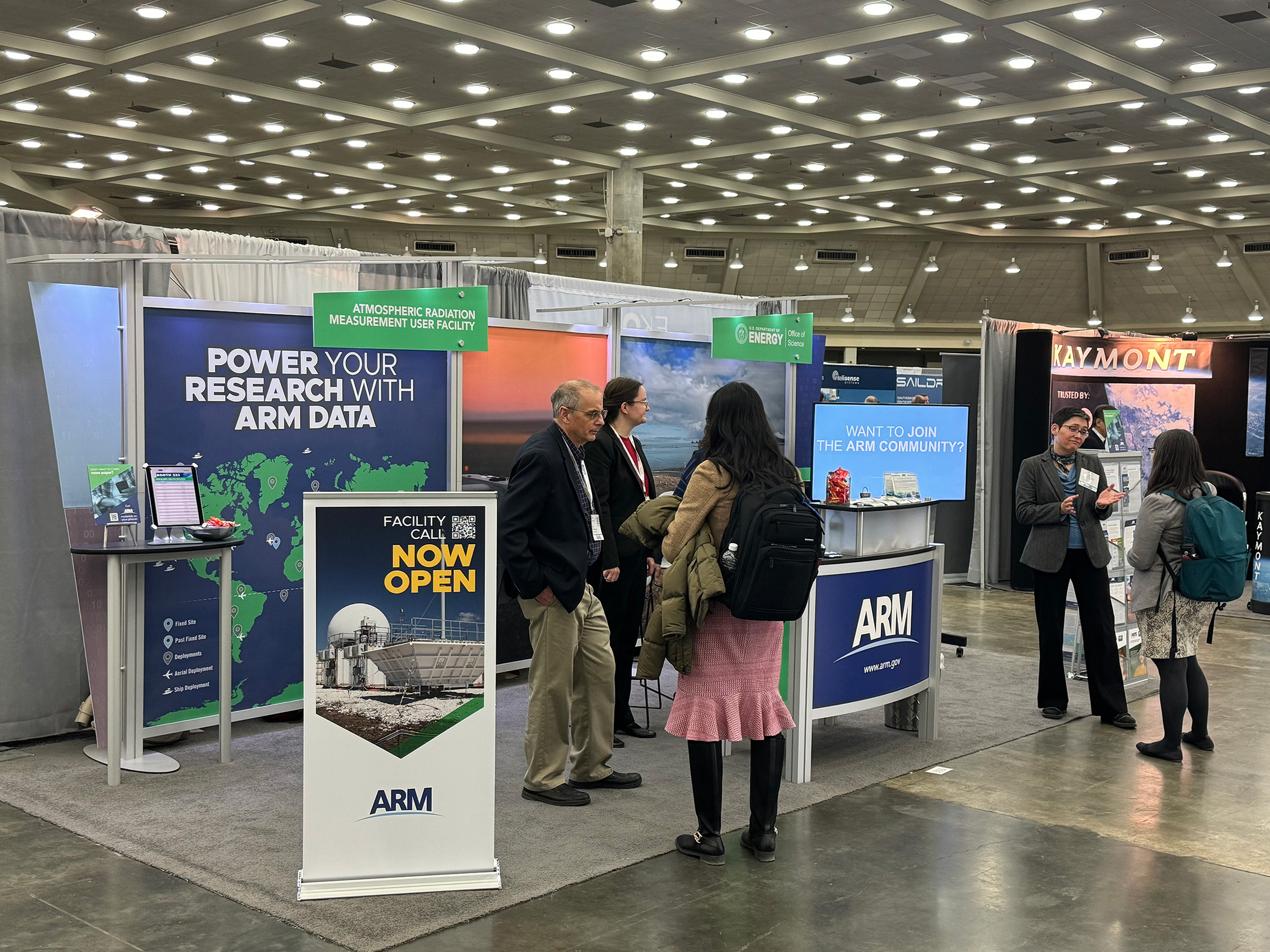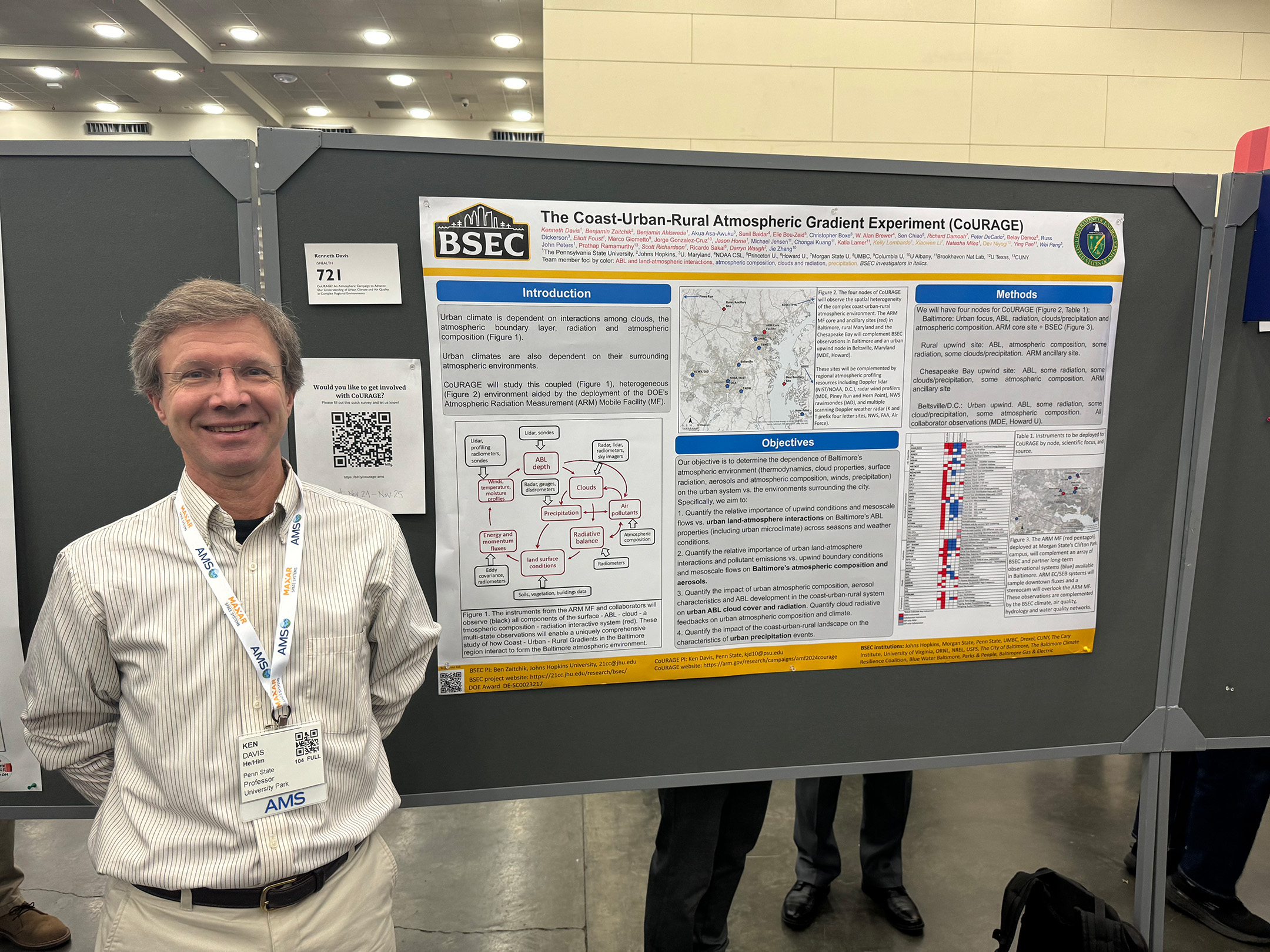Presentations featuring ASR science and ARM data make a lasting impression at AMS Annual Meeting in Baltimore, Maryland

Members of the weather, water, and climate community came together for the 104th American Meteorological Society (AMS) Annual Meeting, held from January 28 to February 1, 2024, in Baltimore, Maryland, and online.
Over 7,200 attendees took part in AMS 2024, which featured a variety of sessions that explored the community’s role in helping to improve society’s response to climate and environmental change. The sessions supported the meeting’s theme, “Living in a Changing Environment.”
The U.S. Department of Energy’s (DOE) Atmospheric Radiation Measurement (ARM) user facility hosted an in-person exhibit at the Baltimore Convention Center. More than 400 booth visitors met with representatives from ARM and DOE’s Atmospheric System Research (ASR) program, heard about an upcoming field campaign in Baltimore and other ARM Mobile Facility deployments, and learned how to access freely available ARM data.
ASR- and ARM-Related Science Have Big Impact
ASR resources and ARM capabilities were the focus of a presentation by DOE Program Managers Shaima Nasiri of ASR and Sally McFarlane of ARM.
Their presentation—part of a session on career pathways—provided details on accessing ARM data and computational resources, and it outlined the ARM and ASR proposal process. The presentation also discussed DOE outreach, including ongoing efforts to expand research at institutions historically underrepresented in the DOE portfolio.
In total, AMS included more than 90 ASR- and ARM-related presentations. A range of presenters, from students to professionals, gave talks that highlighted ASR-supported research and ARM data and capabilities.
AMS included more than 90 ASR- and ARM-related presentations. A range of presenters, from students to professionals, gave talks that highlighted ASR-supported research and ARM data and capabilities.
Kaiden Sookdar, an atmospheric science undergraduate student at Cornell University, presented a poster on using Cimel sunphotometer data from ARM’s Southern Great Plains and Eastern North Atlantic atmospheric observatories to evaluate microphysical cloud properties.
Sookdar is a former participant in DOE’s Science Undergraduate Laboratory Internships (SULI) program. As part of the SULI program, Sookdar completed an internship at Brookhaven National Laboratory in New York under the mentorship of meteorologist Scott Giangrande, who served as ARM’s cloud processes translator until early 2024.
Max Grover, an atmospheric data scientist at Argonne National Laboratory in Illinois, led a presentation detailing a new open-source radar package and its planned implementation within the Python ARM Radar Toolkit (Py-ART). Developed by the Open Radar Science Community, the Xradar package uses a new global weather radar data standard set by the World Meteorological Organization.
During the presentation, which was co-authored by fellow Argonne researchers Scott Collis, Robert Jackson, and Joseph O’Brien, Grover shared Xradar highlights and progress on the new package.
ARM Field Campaigns Highlighted

Data from ARM’s TRacking Aerosol Convection interactions ExpeRiment (TRACER) regularly came up in conversation across the convention center. The 2021–2022 field campaign collected convective cloud observations over a broad range of environmental conditions around Houston, Texas, to help researchers better represent deep convection in multiscale models.
TRACER Principal Investigator Michael Jensen, a Brookhaven Lab meteorologist, was available to answer questions during an oral presentation on ongoing and planned measurement and modeling activities using TRACER data.
In another session, Dié Wang, a cloud process researcher at Brookhaven Lab, presented a poster on how aerosols affected rainfall core depth within deep convective clouds observed during TRACER.
ARM’s Surface Atmosphere Integrated Field Laboratory (SAIL) campaign, which wrapped up a nearly two-year operational phase in June 2023, inspired presentations on hydrology, aerosol interactions, and precipitation analysis, among other topics.
SAIL took place in the East River Watershed near Crested Butte, Colorado, and provided atmospheric data that researchers are using to develop detailed measurements of mountainous water-cycle processes pertaining to the Colorado River. The river supplies water for 40 million people in the Western United States.
SAIL Principal Investigator Daniel Feldman, a climate modeling and remote sensing expert at Lawrence Berkeley National Laboratory in California, chaired an AMS oral session on mountain hydrology that included presentations featuring SAIL data.
During another session, Aaron Kennedy, an associate professor of atmospheric sciences at the University of North Dakota, presented a poster that showcased imagery from snowfall cameras deployed near SAIL’s main site in Gothic, Colorado.
While ARM’s Eastern Pacific Cloud Aerosol Precipitation Experiment (EPCAPE) was still within its operational period during AMS, researchers eagerly discussed initial data obtained from the field campaign.
EPCAPE, whose yearlong operational phase ended February 14 in La Jolla, California, will help scientists explore aerosol indirect effects on stratocumulus clouds to help improve their representation in earth system models.
Jeramy Dedrick and Christian Pelayo are PhD students working with EPCAPE Principal Investigator Lynn Russell at the University of California San Diego’s Scripps Institution of Oceanography. Dedrick presented a poster on aerosol size distribution signatures found in coastal marine stratocumulus clouds using measurements from EPCAPE’s Mount Soledad site. Pelayo’s EPCAPE poster featured analysis of aerosol composition during low-cloud conditions at Mount Soledad and the Ellen Browning Scripps Memorial Pier.
A Taste of CoURAGE

Coming to Baltimore later this year is ARM’s Coast-Urban-Rural Atmospheric Gradient Experiment (CoURAGE).
Expected to run from December 2024 through November 2025, the campaign will study surface-atmosphere interactions to see how they influence Baltimore’s climate.
With data collected at sites in and around Baltimore, CoURAGE will be able to document the degree to which different surface conditions around the region can change the city’s atmospheric environment.
During AMS, CoURAGE Principal Investigator Kenneth Davis, professor of atmospheric and climate science at Pennsylvania State University, presented a high-level overview poster of the upcoming campaign.
CoURAGE will complement the Baltimore Social-Environmental Collaborative (BSEC), a DOE Urban Integrated Field Laboratory. AMS included a panel discussion on BSEC and a session on the urban lab initiative.
See the full list of reported ARM-related AMS presentations.
In Closing
If you missed AMS 2024, you can browse presentation abstracts and watch session recordings on the meeting agenda web page. AMS meeting registration is required to watch recordings.
AMS 2025 will be held from January 12 to 16 in New Orleans, Louisiana.
# # #This work was supported by the U.S. Department of Energy’s Office of Science, through the Biological and Environmental Research program as part of the Atmospheric System Research program.

